

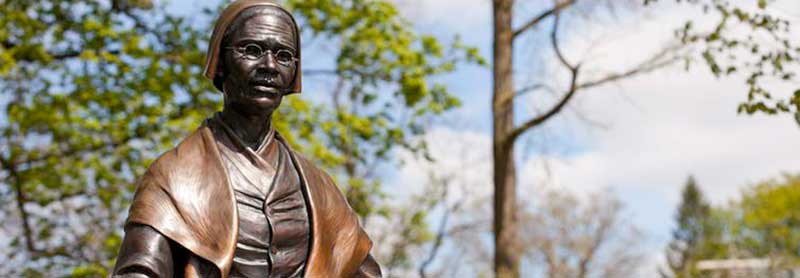
Hidden figures: How black women preachers spoke truth to power

Sojourner Truth Memorial in Florence, Massachusetts.
Lynne Graves, CC BY-ND
Each semester I greet the students who file into my preaching class at Howard University with a standard talk. The talk is not an overview of the basics – techniques of sermon preparation or sermon delivery, as one might expect. Outlining the basics is not particularly difficult.
The greatest challenge, in fact, is helping learners to stretch their theology: namely, how they perceive who God is and convey what God is like in their sermons. This becomes particularly important for African-American preachers, especially African-American women preachers, because most come from church contexts that overuse exclusively masculine language for God and humanity.
African-American women comprise more than 70 percent of the active membership of generally any African-American congregation one might attend today. According to one Pew study, African-American women are among the most religiously committed of the Protestant demographic – eight in 10 say that religion is important to them.
Yet, America’s Christian pulpits, especially African-American pulpits, remain male-dominated spaces. Still today, eyebrows raise, churches split, pews empty and recommendation letters get lost at a woman’s mention that God has called her to preach.
The deciding factor for women desiring to pastor and be accorded respect equal to their male counterparts generally whittles down to one question: Can she preach?
The fact is that African-American women have preached, formed congregations and confronted many racial injustices since the slavery era.
Here’s the history
The earliest black female preacher was a Methodist woman simply known as Elizabeth. She held her first prayer meeting in Baltimore in 1808 and preached for about 50 years before retiring to Philadelphia to live among the Quakers.

First African-American church, founded by Rev. Richard Allen. D Smith, CC BY-NC
An unbroken legacy of African-American women preachers persisted even long after Elizabeth. Reverend Jarena Lee became the first African-American woman to preach at the African Methodist Episcopal (AME) Church. She had started even before the church was officially formed in the city of Philadelphia in 1816. But, she faced considerable opposition.
AME Bishop Richard Allen, who founded the AME Church, had initially refused Lee’s request to preach. It was only upon hearing her speak, presumably, from the floor, during a worship service, that he permitted her to give a sermon.
Lee reported that Bishop Allen, “rose up in the assembly, and related that [she] had called upon him eight years before, asking to be permitted to preach, and that he had put [her] off; but that he now as much believed that [she] was called to that work, as any of the preachers present.
Lee was much like her Colonial-era contemporary, the famed women’s rights activist Sojourner Truth. Truth had escaped John Dumont’s slave plantation in 1828 and landed in New York City, where she became an itinerant preacher active in the abolition and woman’s suffrage movements.
Fighting the gender narratives
For centuries now, the Holy Bible has been used to suppress women’s voices. These early female black preachers reinterpreted the Bible to liberate women.
Truth, for example, is most remembered for her captivating topical sermon “Ar’nt I A Woman?,” delivered at the Woman’s Rights National Convention on May 29, 1851 in Akron, Ohio.
In a skillful historical interpretation of the scriptures, in her convention address, Truth used the Bible to liberate and set the record straight about women’s rights. She professed:
“Then that little man in black there, he says women can’t have as much rights as men, because Christ wasn’t a woman! Where did your Christ come from? From God and a woman! Man had nothing to do with Him.”
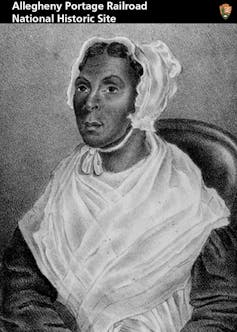
Jarena Lee. TradingCardsNPS (CC)
Like Truth, Jarena Lee spoke truth to power and paved the way for other mid- to late 19th-century black female preachers to achieve validation as pulpit leaders, although neither she nor Truth received official clerical appointments.
The first woman to achieve this validation was Julia A. J. Foote. In 1884, she became the first woman ordained a deacon in the African Methodist Episcopal Zion AMEZ Church. Shortly after followed the ordinations of AME evangelist Harriet A. Baker, who in 1889 was perhaps the first black woman to receive a pastoral appointment. Mary J. Small became the first woman to achieve “elder ordination” status, which permitted her to preach, teach and administer the sacraments and Holy Communion.
Historian Bettye Collier-Thomas maintains that the goal for most black women seeking ordination in the late 19th and early 20th centuries was simply a matter of gender inclusion, not necessarily pursuing the need to transform the patriarchal church.
Preaching justice
An important voice was that of Rev. Florence Spearing Randolph. In her role as reformer, suffragist, evangelist and pastor, she daringly advanced the cause of freedom and justice within the churches she served and even beyond during the period of the Great Migration of 20th century.
In my book, “A Pursued Justice: Black Preaching from the Great Migration to Civil Rights,” I trace the clerical legacy of Rev. Randolph and describe how her prophetic sermons spoke to the spiritual, social and industrial conditions of her African-American listeners before and during the largest internal migration in the United States.
In her sermons she brought criticism to the broken promises of American democracy, the deceptive ideology of black inferiority and other chronic injustices.
Randolph’s sermon “If I Were White,” preached on Race Relations Sunday, Feb. 1, 1941, reminded her listeners of their self-worth. It emphasized that America’s whites who claim to be defending democracy in wartime have an obligation to all American citizens.
Randolph spoke in concrete language. She argued that the refusal of whites to act justly toward blacks, domestically and abroad, embraced sin rather than Christ. That, she said, revealed a realistic picture of America’s race problem.
She also spoke about gender discrimination. Randolph’s carefully crafted sermon in 1909 “Antipathy to Women Preachers,” for example, highlights several heroic women in the Bible. From her interpretation of their scriptural legacy, she argued that gender discrimination in Christian pulpits illustrated a misreading of scripture.
Randolph used her position as preacher to effect social change. She was a member and organizer for the Woman’s Christian Temperance Union (WCTU), which led in the work to pass the 18th Amendment, which made prohibition of the production, sale and transport of alcoholic beverages illegal in the United States. Her affiliation with the WCTU earned her the title “militant herald of temperance and righteousness.”
![]() Today, several respected African-American women preachers and teachers of preachers proudly stand on Lee’s, Small’s and Randolph’s shoulders raising their prophetic voices.
Today, several respected African-American women preachers and teachers of preachers proudly stand on Lee’s, Small’s and Randolph’s shoulders raising their prophetic voices.
Kenyatta R. Gilbert, Associate Professor of Homiletics, Howard University
This article was originally published on The Conversation. Read the original article.

How putting purpose into your New Year’s resolutions can bring meaning and results

Prostock studio/Shutterstock.com
People worldwide make New Year’s resolutions every year in an attempt to improve their lives. Common resolutions are to exercise more, eat healthier, save money, lose weight and reduce stress.
Yet, 80% of people agree that most people won’t stick to their resolutions. This pessimism is somewhat justified. Only 4% of people report following through on all of the resolutions they personally set.
We have spent years studying motivation, emotion regulation and behavior in family relationships, athletic performance and health information processing in the marketplace. Now at USC’s Performance Science Institute, we help people attain and sustain high performance in all aspects of their lives.
Based on our research, we propose a potential solution to the problem of New Year’s resolutions that people can’t keep: encouraging people to reframe their resolutions to emphasize purpose-based performance.
Why the failures?
What leads to so many abandoned New Year’s resolutions?
A large body of research on goal-setting and habits provides insight into the various reasons for failed resolutions.
Many people are not framing their resolutions in ways that will motivate them over time. For example, “exercise more” is a fairly clear directive, but it lacks depth and personal meaning that could help promote follow through. Overly simplified resolutions, such as “exercise more” and “eat healthier” contribute to the ongoing problem that emerges as early as mid-January each year: unintentional neglect of important self-improvement goals.

Kiefer Pix/Shutterstock.com
Make it purposeful
Purpose has been defined simply as someone’s reason for doing something. However, scientists have recently developed a more comprehensive framework for purpose.
Purpose is associated with positive outcomes for people of all ages. People with a sense of purpose make more money, cope with life hardships more effectively and are healthier across the lifespan. Organizations that foster or reinforce employees’ sense of purpose are now referred to as “high performance workplaces”.
In the context of goal-setting for the new year, the concept of purpose-based performance becomes especially relevant. In our research, we have found that purpose-based performance is much healthier and more sustainable than outcome-driven performance.
Purpose-based performance has three critical, interrelated components: goal orientation, personal meaning and focus on something or someone beyond the self. We provide three questions that you can ask yourself when developing New Year’s resolutions to inspire purpose-based performance.
What are my longer-term goals?
The first thing to consider is your long-term goals, and how each resolution fits with those goals. Purpose-based performance includes goal orientation, or an internal compass that directs people toward some long-term aim. This orientation helps people organize and prioritize more immediate actions to make progress toward that aim. People who are goal-oriented and remind themselves of their “end game” live consistently with their beliefs and values and perform better on the immediate goals they set.
When setting New Year’s resolutions, many people end up with a long list of simple resolutions without thinking deeply about their rationale for each resolution, or where each resolution will take them. Linking an immediate goal with a longer-term aim can sustain progress. Thinking about who you want to become can help you decide which resolution(s) to take on.
Why is this personally important?
The next step to consider is why each resolution is personally meaningful for you. When people pursue personally meaningful goals, they are not only more intrinsically motivated but also find more joy in the process of goal pursuit. They are able to reframe challenges as opportunities for personal growth. In one study with elite athletes, we found that personal meaning helped them regulate their emotions when things didn’t go their way and display more patience as they pursued their goals.
Someone who pursues a goal for external rewards that are contingent on a particular end result – for example, validation that comes from winning – is likely to experience shame when they fall short of their goal. Even when they win, they may feel disappointed because the end result does not bring meaning to their life. This is exemplified by the “post-Olympic blues,” when Olympians experience depression after such a significant accomplishment.
Spend time thinking about your motivation for each resolution. Ask yourself, are you focused on a particular outcome because it will give you self-esteem, status or something else? It can be helpful to think about the potential meaning found in the process of pursuing a goal, regardless of whether you attain the desired outcome.
Who will be positively affected by this?
The final step is to consider who or what, beyond yourself, will be positively affected by your resolution(s). Desire to be a part of something greater than the self, or transcendent motivation, is beneficial for performance for several reasons.

Pixel head photo digital skillet/Shutterstock.com
Linking a resolution to transcendent motivation can be a powerful source of inspiration. Someone may link exercise goals to a charitable cause they care about, or they may think about how improving their health will make them a better partner, friend or parent. Research shows transcendent motivation improves self-regulation when things get dull or repetitive during goal pursuit, and it strengthens character virtues like patience and generosity. When someone’s transcendent motivation is prosocial in nature, they are willing to accept feedback about performance and receive increased social support in the workplace.
Think about the bigger picture. Consider whom you are helping with each goal. Potential impact beyond yourself is added fuel for your goal pursuit.
Reframing your resolutions
What might New Year’s resolutions that incorporate purpose-based performance look like? Using the three questions above, we have reworked three common resolutions to reflect purpose-based performance:
- “Exercise more” becomes “I commit to working out two times per week so I can be more present and energized with my children, so they feel more loved and inspired by me.”
- “Save money” becomes “I commit to saving US$100 per paycheck so I feel more secure in my role as a husband and father, which will ultimately benefit my family.”
- “Lose weight” becomes “I commit to losing ten pounds so I feel more confident at work, and my coworkers will experience a more positive version of me.”
Cheers to a new, purpose-filled year!
[ Deep knowledge, daily. Sign up for The Conversation’s newsletter. ]![]()
Benjamin Houltberg, Research Director, Performance Science Institute, University of Southern California and Arianna Uhalde, Assistant Professor of Clinical Marketing, University of Southern California
This article is republished from The Conversation under a Creative Commons license. Read the original article.
Thanksgiving hymns are a few centuries old, tops – but biblical psalms of gratitude and praise go back thousands of years
King David playing the lyre in a scene from a 15th-century manuscript of the Book of Psalms. Historica Graphica Collection/Heritage Images/Hulton Archive via Getty Images David W. Stowe, Michigan State University Thanksgiving doesn’t ring in the ear for months on end,...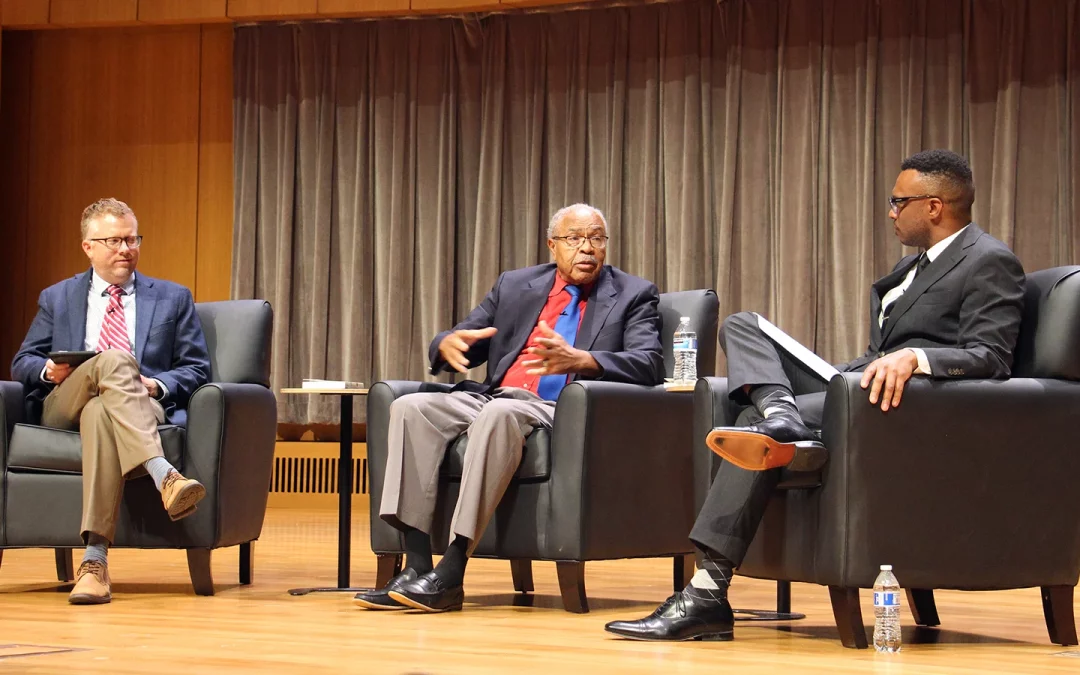
‘Tell what happened’: Pastor and last surviving eyewitness urges Christians to remember Emmett Till
WHEATON, Ill. (RNS) — The Rev. Wheeler Parker Jr. still remembers clearly the moment as a teenager he thought he was going to die.
Parker was 16 years old, visiting family in Mississippi, when he woke in the early morning hours to the sound of voices in the house. Moments later, the door to his bedroom opened and a man pointed a flashlight and a pistol in his face.
He shut his eyes tight, but the shot never came.
The man moved on to the next bedroom and the next before finding and kidnapping his cousin — Emmett Till.
It was the last time he saw his best friend alive, Parker, now in his 80s, told a packed concert hall Tuesday night (Oct. 25) at Wheaton College, the evangelical flagship school in the Chicago suburbs.
What happened next — Till’s brutal murder, his mother’s decision to allow an open casket at the 14-year-old victim’s funeral, so the country could see what had been done to her son — shone a light on racial violence in the United States and became a catalyst for the civil rights movement.
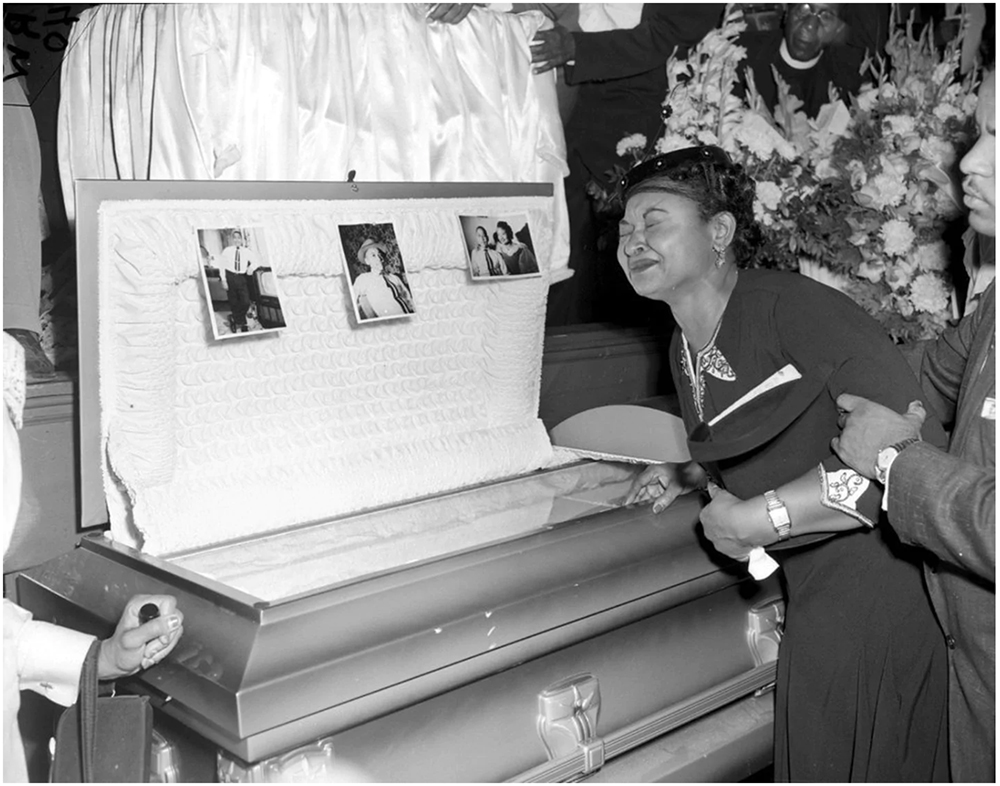
Mamie Till-Mobley weeps at her son’s funeral on Sept. 6, 1955, in Chicago. (Chicago Sun-Times/AP Photo)
“A picture’s worth a thousand words. That picture made a statement. It went throughout the world, all over the world, and it still speaks,” Parker said of the photographs of Till in his casket, taken by David Jackson and first published in Jet magazine.
The story of Till continues to resonate because it “provides us with a lens to understand racial conflict in our own moment,” said Theon Hill, associate professor of communications at Wheaton College and primary organizer and moderator of Tuesday’s event, “Remembering Emmett Till: A Conversation on Race, Nation and Faith.”
“When we see George Floyd killed right in front of us due to the officer’s knee,” said Hill, “when we see Breonna Taylor’s death, when we see Ahmaud Arbery, we’re trying to make sense of what’s happening, and Till’s death, as tragic as it will always be, provides us with a grammar to understand this is what’s happening and this is how you might respond in your moment.”
The enduring relevance of Till’s death is apparent in the Emmett Till Antilynching Act, making lynching a federal hate crime and signed in March by President Joe Biden, nearly 70 years after Till’s murder.
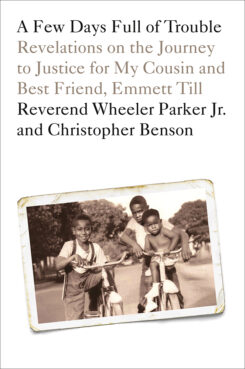
“A Few Days Full of Trouble: Revelations on the Journey to Justice for My Cousin and Best Friend, Emmett Till” by the Rev. Wheeler Parker Jr. and Christopher Benson. Courtesy image
It’s also borne out in the critical acclaim for a new film, “Till,” centering on Till’s mother, Mamie Till-Mobley, and her fight for justice for her son, which appears in theaters nationwide this week. In January, Parker will publish his recollections of his cousin, “A Few Days Full of Trouble: Revelations on the Journey to Justice for My Cousin and Best Friend, Emmett Till.”
It was 30 years before anybody asked Parker his account of what had happened over the handful of days in 1955 he and his cousin, who lived in Chicago, spent in Mississippi visiting family, according to Parker, the last surviving witness to Till’s abduction.
In Parker’s account, Till is a jokester, the boy next door he accompanied fishing, picnicking and on other trips. When his cousin found out he was planning to take the train down South to visit his grandfather, he insisted on going too.
“If you didn’t live in Mississippi at that time or experience what it was like, you have no idea what it was like,” Parker said.
He had lived in the South until he was 7 and knew “what you had to do to stay alive and what could happen to you,” he said.
Till didn’t.
When the younger boy whistled in the presence of a white woman outside a store, Parker said, the cousins left in a hurry. He worried what could happen in a place and time when a Black man couldn’t so much as look at a white woman, he said.
But days passed, and they’d nearly forgotten about the incident. Then came the moment Parker heard voices in his grandfather’s home at about 2:30 a.m. on a Sunday morning, asking about the boys from Chicago.
“Sunday morning should be the safest place on earth for a young man in his house — on Sunday morning, waiting to go to church,” he said.
Shaking and sure he was about to die, he prayed, “God, if you just let me live, I’m going to get my life together.”
That Monday, he returned to Chicago alone, his life changed “completely,” said Parker, now pastor and district superintendent of the Argo Temple Church of God in Christ in Summit, Illinois.
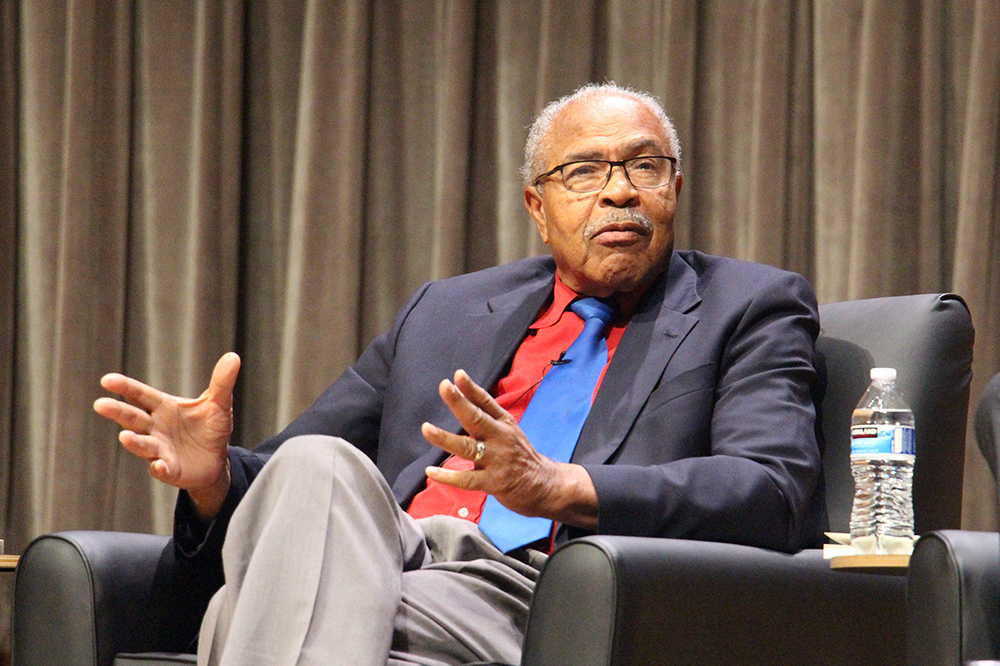
The Rev. Wheeler Parker Jr. speaks during the “Remembering Emmett Till: A Conversation on Race, Nation and Faith” event at Wheaton College, Oct. 25, 2022, in Wheaton, Illinois. RNS photo by Emily McFarlan Miller
What happened to Till changed the country, too.
Dave Tell, author of the 2019 book “Remembering Emmett Till,” told the audience Tuesday night that he had become invested in civil rights because of Till’s story.
“The Till story prompted a new generation to stand up for justice, and I think the good news of the night is that the Till story — Rev. Parker’s story — is still motivating a new generation,” Tell said.
It’s a story, he said, the U.S. needs to hear today more than ever. Considering the stories of Floyd and others against the backdrop of Till’s murder, it’s hard to minimize their killings as “a problem of a bad apple or bad cop,” he said.
And the church has a role to play in sharing that story, both Tell and Parker agreed.
The biblical Book of Genesis tells the story of Abel, murdered by his brother Cain, Tell pointed out. In the story, God says Abel’s blood cries out to him from the ground, where Cain has tried to bury what he did.
If God demands that voices that have been buried be brought to light as part of the work of justice and healing, shouldn’t the church? Tell asked.
“We’ve got to keep the legacy going — got to keep the story going — and not with animosity,” Parker added.
“Just tell the story. It’s history. It’s real. Tell what happened,” he said.
